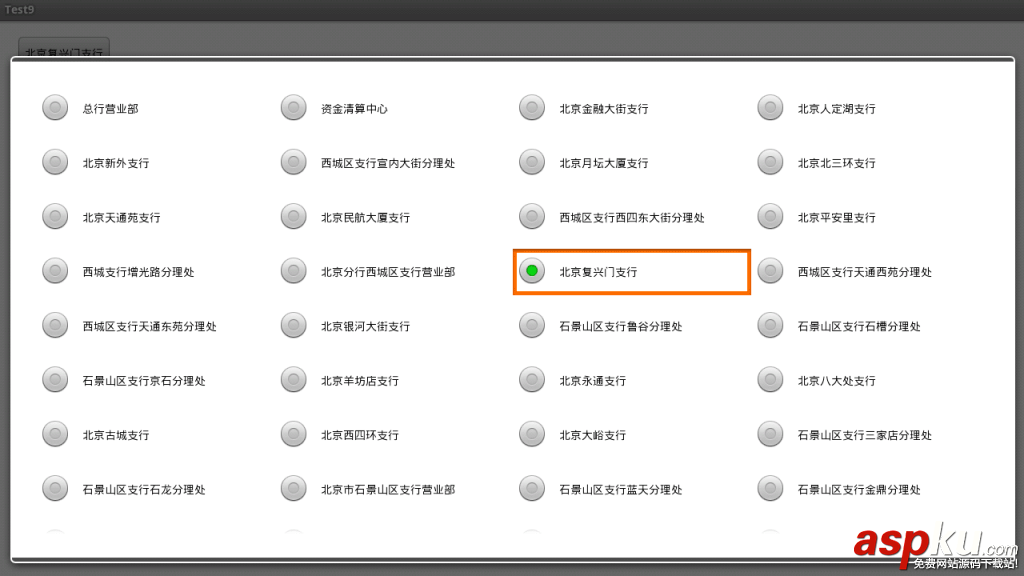本文實例講述了Android編程實現多列顯示的下拉列表框Spinner功能。分享給大家供大家參考,具體如下:
先上張效果圖:

嚴格來說,這并不是一個下拉列表,只不過實現的效果很像是下拉列表
實現原理:
該下拉列表其實是一個AlertDialog.Builder,給它設置了一個以LinearLayout布局的View。該View內使用了一個GridView組件,
代碼:
package yyy.testandroid9;private Intent intent;private int index = 0;private SharedPreferences preferences;private File file;private Spinner spinner;private GridView gridView;private LinearLayout layout;private Builder builder;private AlertDialog dialog;private MyAdapter adapter;/** Called when the activity is first created. */@Overridepublic void onCreate(Bundle savedInstanceState) { super.onCreate(savedInstanceState); setContentView(R.layout.main); LayoutInflater inflater = LayoutInflater.from(this); layout = (LinearLayout) inflater.inflate(R.layout.bank_grid, null); gridView = (GridView) layout.findViewById(R.id.grid); adapter = new MyAdapter(this); gridView.setAdapter(adapter); button1 = (Button) findViewById(R.id.button1); button2 = (Button) findViewById(R.id.button2); textView = (TextView) findViewById(R.id.textview); builder = new Builder(TestAndroid9Activity.this); builder.setView(layout); button1.setOnClickListener(new OnClickListener() { public void onClick(View arg0) { // TODO Auto-generated method stub if(dialog == null){ dialog = builder.show(); } dialog.show(); } }); gridView.setOnItemClickListener(new OnItemClickListener() { public void onItemClick(AdapterView<?> arg0, View arg1, int position, long arg3) { // TODO Auto-generated method stub button1.setText(getResources().getStringArray(R.array.city)[position]); dialog.dismiss(); adapter.map.put(index, false); adapter.map.put(position, true); index = position; adapter.notifyDataSetChanged(); } });}private class MyAdapter extends BaseAdapter{ private Context context; private String[] citys; private LayoutInflater inflater; public HashMap<Integer, Boolean> map; public MyAdapter(Context context) { super(); this.context = context; citys = context.getResources().getStringArray(R.array.city); inflater = LayoutInflater.from(context); map = new HashMap<Integer, Boolean>(); for(int i=0;i<citys.length;i++){ map.put(i, false); } } public int getCount() { // TODO Auto-generated method stub return citys.length; } public Object getItem(int position) { // TODO Auto-generated method stub return null; } public long getItemId(int position) { // TODO Auto-generated method stub return position; } public View getView(int position, View view, ViewGroup parent) { // TODO Auto-generated method stub if(view == null){ view = inflater.inflate(R.layout.bank_item, null); } TextView textView = (TextView) view.findViewById(R.id.list_text); RadioButton radioButton = (RadioButton) view.findViewById(R.id.radiobutton); radioButton.setChecked(map.get(position)); textView.setText(citys[position]); return view; }}bank_grid.xml
<?xml version="1.0" encoding="utf-8"?><LinearLayout xmlns:android="http://schemas.android.com/apk/res/android" android:layout_width="fill_parent" android:layout_height="fill_parent" android:orientation="vertical" android:padding="20dp" android:background="#ffffff" android:id="@+id/grid_layout"> <GridView android:id="@+id/grid" android:layout_width="fill_parent" android:layout_height="fill_parent" android:verticalSpacing="20px" android:horizontalSpacing="10px" android:numColumns="4" android:scrollbars="vertical" android:layout_margin="10dp"/></LinearLayout>
bank_item.xml
<?xml version="1.0" encoding="utf-8"?><LinearLayout xmlns:android="http://schemas.android.com/apk/res/android" android:layout_width="fill_parent" android:layout_height="fill_parent" android:background="#ffffff" > <RadioButton android:id="@+id/radiobutton" android:layout_width="wrap_content" android:layout_height="wrap_content" android:layout_marginRight="15dp" android:focusable="false" android:clickable="false" android:focusableInTouchMode="false" /> <TextView android:id="@+id/list_text" android:layout_width="wrap_content" android:layout_height="wrap_content" android:textColor="#000000" android:layout_gravity="center_vertical"/></LinearLayout>
希望本文所述對大家Android程序設計有所幫助。
新聞熱點
疑難解答